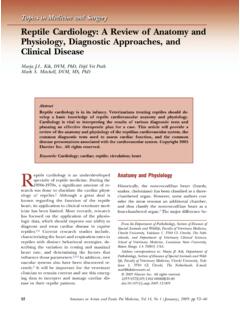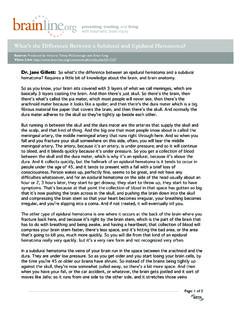Transcription of Dermatomes Anatomy Overview - maineddc.org
1 Dermatomes Anatomy Overview The surface of the skin is divided into specific areas called Dermatomes , which are derived from the cells of a somite. These cells differentiate into the following 3 regions: (1) myotome, which forms some of the skeletal muscle; (2) dermatome , which forms the connective tissues, including the dermis; and (3) sclerotome, which gives rise to the vertebrae. A dermatome is an area of skin in which sensory nerves derive from a single spinal nerve root (see the following image). Dermatomes of the head, face, and neck. There are 31 segments of the spinal cord, each with a pair (right and left) of ventral (anterior) and dorsal (posterior) nerve roots that innervate motor and sensory function, respectively.
2 The anterior and posterior nerve roots combine on each side to form the spinal nerves as they exit the vertebral canal through the intervertebral foramina or neuroforamina. The 31 spine segments on each side give rise to 31 spinal nerves, which are composed of 8 cervical, 12 thoracic, 5 lumbar, 5 sacral, and 1 coccygeal spinal nerve. Dermatomes exist for each of these spinal nerves, except the first cervical spinal nerve. Sensory information from a specific dermatome is transmitted by the sensory nerve fibers to the spinal nerve of a specific segment of the spinal cord. The C1-C7 nerve roots emerge above their respective vertebrae; the C8 nerve root emerges between the C7 and T1 vertebrae.
3 The remaining nerve roots emerge below their respective vertebrae. Along the thorax and abdomen, the Dermatomes are evenly spaced segments stacked up on top of each other, and each is supplied by a different spinal nerve. The Dermatomes along the arms and legs differ from the pattern of the trunk Dermatomes , because they run longitudinally along the limbs. The general pattern is similar in all people, but significant variations exist in dermatome maps from person to person.[1]. Clinical significance Adapted from Dermatomes are useful to help localize neurologic levels, particularly in radiculopathy. Effacement or encroachment of a spinal nerve may or may not exhibit symptoms in the dermatomic area covered by the compressed nerve roots in addition to weakness, or deep tendon reflex loss.
4 Viruses that infect spinal nerves, such as herpes zoster infections (shingles), can reveal their origin by showing up as a painful dermatomic area. Herpes zoster, a virus that can be dormant in the dorsal root ganglion, migrates along the spinal nerve to affect only the area of skin served by that nerve. American spinal Injury Association classification Dermatomes are clinically important and necessary for assessing and diagnosing the level of spinal cord injury in the American spinal Injury Association (ASIA) Impairment scale.[2]. Gross Anatomy Basic Anatomy , dorsal (sensory) roots The cell bodies of sensory neurons of spinal nerves are located in the dorsal root ganglia.
5 [3, 4, 5] Each dorsal root contains the input from all the structures within the distribution of its corresponding body segment (ie, somite). Dermatomal maps portray sensory distributions for each level. These maps differ somewhat according to the methods used in their construction. Charts based on injection of local anesthetics into single dorsal root ganglia show bands of hypalgesia to be continuous longitudinally from the periphery to the spine. Maps derived from other methods, such as observation of herpes zoster lesion distributions or surgical root section, show discontinuous patterns. In addition, innervation from one dermatomal segment to another overlaps considerably, more so for touch than for pain.
6 As the Dermatomes travel from the back to the chest and abdomen, they tend to dip inferiorly.[6]. See the following dermatome maps. Dermatomes of the head, face, and neck. Adapted from Dermatomes of the trunk and back. Dermatomes of the extremities. Clinically important Dermatomes Upper extremity C6 - Thumb C7 - Middle finger C8 - Little finger T1 - Inner forearm T2 - Upper inner arm Lower extremity L3 - Knee L4 - Medial malleolus L5 - Dorsum of foot L5 - Toes 1-3. S1 - Toes 4 and 5; lateral malleolus Other C2 and C3 - Posterior head and neck T4 - Nipple T10 Umbilicus Natural Variants The dermatome is a basic concept, yet much variability exists between dermatome maps in standard Anatomy and medical guideline textbooks.
7 A review of 14 different dermatome maps by Lee et al showed striking variations within each individual map.[7]Nearly all maps reviewed were based on 2 primary sources, Foerster[8] and/or Keegan and Garrett.[9]. Most areas of the skin are innervated by 2 or more spinal nerve roots, which may be the reason for variability between individuals. Other possibilities of such variability could be due to intrathecal intersegmental anastomoses of dorsal spinal rootlets, allowing ensory neurons at one dorsal root ganglion to enter the spinal cord at a different level.[7]. Adapted from Other Considerations blood supply The spinal cord and its associated spinal nerves are supplied by a single anterior spinal artery and 2 posterior spinal arteries.
8 The anterior spinal artery supplies the anterior two thirds of the cord. The posterior spinal arteries supply the dorsal columns. All three spinal arteries arise from the vertebral arteries in the skull and descend through the base of the skull. Segmental branches of the thoracic and abdominal aorta have radicular branches that anastomose with the spinal arteries to provide additional blood supply to the spinal arteries. One of the largest radicular branches, the great radicular artery or artery of Adamkiewicz, supplies the anterior spinal artery, which enters the spinal cord between T5 and L1, with the most common entry point between T9 and T12.
9 Development Dermatomes are derived from the outer portion of an embryo from which the skin and subcutaneous tissues are developed and become the areas of skin supplied by the branches of a single dorsal root ganglion. In the developing embryo, Dermatomes arise from somitic mesoderm, which develops from the middle layer of embryonic tissue lateral to the developing neural tube. Dermatomes are arranged with basic segmental pattern in the vertebrate trunk, although some overlap exists with similar areas above and below. Dermatologic mapping Dermatomes of the head, face, and neck Below, Image 1 depicts and Table 1 describes the head, face, and neck Dermatomes .
10 Dermatomes of the head, face, and neck. Adapted from Table 1. Dermatomes of the Head and Neck spinal Component Skin Distribution Divisions of the trigeminal nerve (cranial nerve [CN] Most of the skin of the face, including anterior aspect of lower jaw (CN V3); the area of skin in front of V1, V2, and V3) both ears; superior part of the lateral aspect of the auricle (CN V3). Skin over the angle of the mandible, anterior to and behind the ear, the anterior neck and back of the Cervical plexus (ventral rami of C2-C4) head and neck; inferior part of the lateral aspect of the auricle and skin on medial aspect of the auricle.







